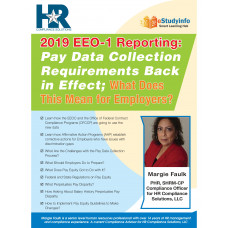2019 EEO-1 Reporting: Pay Data Collection Requirements Back in Effect; What Does This Mean for Employers?
- Author Margie Faulk, PHR, SHRM-CP
- Product Code: ESDB029
- Availability: In Stock
On March 4, 2019, a federal court in Washington, D.C., ordered the Trump administration to reinstate an Obama-era rule that had been placed on hold. The court ruling will require employers to annually report pay data by gender, race and ethnicity to the Equal Employment Opportunity Commission (EEOC).
EEO-1 Disclosure Requirements
For decades, the EEOC has required private employers with 100 or more employees to annually file an EEO-1 report, which breaks down the number of employees in different job categories by gender, race and ethnicity. Federal government contractors and subcontractors with 50 or more employees also are subject to this reporting requirement.
What This Means for Employers
It is not clear how this ruling will impact the 2018 reporting period, for which the current deadline for employers to file EEO-1 reports is May 31, 2019. As of the date of this Alert, neither the OMB nor the EEOC has commented or provided guidance in response to the court’s ruling. The delay is based on the partial government shutdown.
Notably, the court specifically found that requiring employers to comply with the requirement to report pay data in 2019 would not be disruptive because the pay data requirement had been in place for almost a year before it was blocked and employers have been on notice that the stay could be lifted at any time.
The EEOC required qualified Employers to submit their 2018 EEO-1 Report without pay data, by May 31, 2019. Recently, the EEOC notified Employers that the pay data requirement, also called component 2, is due by September 30, 2019. Employers are scrambling to ensure that they can meet the EEO-1 Pay Data Reporting Guidelines by the September Deadline date!
Margie Faulk, PHR, SHRM-CP is a senior level human resources professional with over 14 years of HR management and compliance experience. A current Compliance Advisor for HR Compliance Solutions, LLC
This Booklet write by our expert writer/speaker Margie Faulk, PHR, SHRM-CP and this is intended to provide an overview of the Pay Data EEO-1 Reporting Requirement and to provide information on how employers can step up their efforts in ensuring immigration compliance. (e-Book size: 8 x 11 format 20 pages).
Learning Objectives:
- Learn how the EEOC and the Office of Federal Contract Compliance Programs (OFCCP) are going to use the new data
- Learn how Affirmative Action Programs (AAP) establish corrective actions for Employers who have issues with discrimination gaps
- What job titles do you use to consist of the reporting data you collect
- Learn how conducting an internal audit of pay practices can make Employers heroes to their employees
- Learn what pay bands the EEOC categorizes when they consider pay and compensation data
- Learn what the process is if you are audited by the EEOC or the OFCCP
- Learn how to count employees in multi-state Employer locations
- What Are the Challenges with the Pay Data Collection Process?
- What Should Employers Do to Prepare?
- What Does Pay Equity Got to Do with It?
- Federal and State Regulations on Pay Equity
- What Perpetuates Pay Disparity?
- How Asking About Salary History Perpetuates Pay Disparity
- How to Implement Pay Equity Guidelines to Make Changes?
*Note:- Your e-book will be delivered to the email provided within 2 working days of your completed order. Please remember to check your spam or bulk account.









